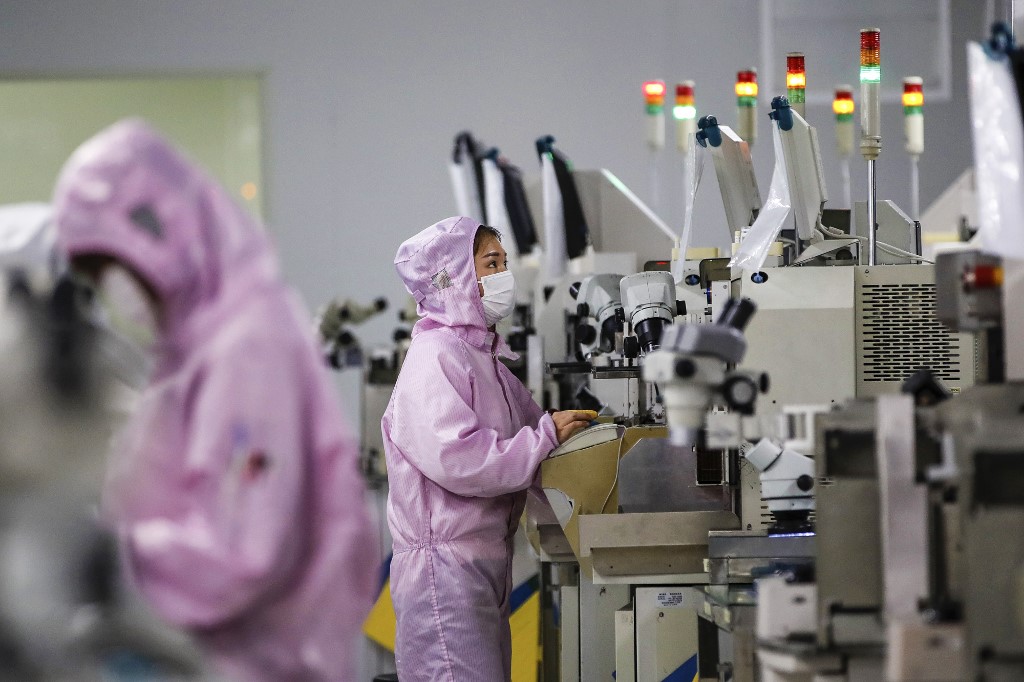(ATF) Last year, China’s imports of computer chips totalled an enormous US$300 billion, surpassing total national expenditure on oil – $240 billion. Indeed, over the past three years, chip imports by companies in China reached an extraordinary 6 trillion yuan (over $901 billion).
The problem for China is it’s missing the vital chip manufacturing element. The most critical part of making semiconductors for computers and mobile phones is the lithography machine.
“If we can break through the lithography machine barrier, it will be a nightmare in Europe and the United States, when the chip is as common as cabbage!” Baidu.com tech commentator Shi Wan proclaimed.
The manufacturing technology of lithography machines is currently a skill dominated by people in Europe and the United States. There are three companies in the world that can make lithography machines. The best is ASML in the Netherlands, which has an EUV lithography machine – the only one that can produce engraving machines for chips lighter than 5nm (nanometres). The other two companies are Canon and Nikon in Japan. But they do not have the EUV capacity, which means they cannot make lithography machines for chips below 5nm.
An official at ASML in the Netherlands once stated: “No country in the world can independently manufacture EUV lithography machines, even if the drawings are given to China, China cannot make them.”
Recently, a Chinese company, Intang Intelligent Controls, made a decisive move to acquire a chip company and let it manufacture chips. Even if the technology cannot be gained immediately, it can at least save considerable cost. And at the same time, the firm improved its manufacturing technology through continuous learning – via reverse engineering, it has admitted.
On October 16, Intang Intelligent Controls formally acquired 100% of the shares in Japanese chip company Pioneer Micro Technology through its subsidiary. Pioneer Micro Technology is now a Chinese company. It is a powerful chip company that designs and manufactures analogue and digital circuit products related to photoelectric conversion and image processing. More importantly, after the acquisition has been completed, the company’s five lithography machines will be packaged and sent to China.
The secretary of Intang Intelligent Controls has officially confirmed that the five lithography machines at Pioneer Micro Technology are already Chinese assets.
China’s chip industry plans a closed loop
Currently, Huawei has the ability to design 5nm chips, but no manufacturing fabrication facilities for chipsets (known as fabs). Following the Sino-US trade war Huawei has learnt that it needs to control all links in the supply chain, as many others have realised after globalisation went into reverse when the coronavirus hit.
Chip manufacturing requires accumulated investment and continuous research and development. The minimum standard for becoming an expert in this field is 15 years of experience. Among China’s chip companies, none are high-end players. SMIC is the top firm currently, but is also struggling now under US sanctions.
Pioneer Micro Technology has strong analogue chip design and production capabilities, which will save Chinese companies a lot of research and development, so they can get started more quickly. Of course, the more critical facet is the patent in hand, which can more effectively boost the domestic chip industry.
China keen to overtake third-generation chip technology
Semiconductor technology has now reached a third generation. The main thing is the change of materials. The third generation of technology is represented by gallium nitride (GaN), silicon carbide (SiC), and diamonds. The industry is still stuck in the second-generation technology based on gallium arsenide. The third generation is only in a small-scale experimental stage.
Third-generation semiconductor technology is characterised by high voltage resistance, high temperature resistance, radiation resistance, strong conductivity, and fast speeds. It has obvious advantages for 5G base stations, power grids, space satellites, high-speed rail, and much more. And in many scenarios, such materials must also be able to maximize performance, otherwise the technology cannot be used without it.
The Pioneer Micro Technology machines acquired this time have a 6-inch wafer production line. After a transformation, it could produce third-generation semiconductor SiC products, and thus accelerate production of third-generation semiconductor chips.
Baidu’s tech commentator Shi Wan wrote: “By going to third generation tech this prevents blindly chasing the footsteps of the West, when we would always be restricted by others. Achieve ‘curve overtaking!’ Just like Huawei on 5G – it caught the United States offguard!”
After the acquisition of these machines from Japan, there are plans for them to be integrated with other technologies. But those details were not revealed.
China is now hoping that it can achieve a goal of 70% chip self-sufficiency by 2025. That could well save it a vast sum.
Meanwhile, China reportedly has plans to curb “chaos” in the chip industry. An official from the National Development and Reform Commission has admitted that some companies have “blindly entered into projects” involving computer chips and wasted considerable resources.
The NDRC has said it will work with banks and funding bodies to improve assessments on proposals involving semiconductors – and hold bosses accountable for risky projects that suffer losses, according to the South China Morning Post.
























